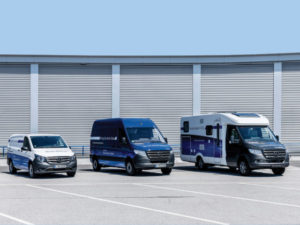The future is electric, as Mercedes-Benz Vans takes the wraps off two new e-van models, Dan Gilkes.

Mercedes-Benz Vans will launch an eVito towards the end of this year, to be followed by the eSprinter in 2019. There will also be an electric Citan at a later date. The eVito will be available in two wheelbases, offering 6.0m3 or 6.6m3 of load volume. Both models will be powered by three lithium-ion battery packs, from Mercedes’ S-Class plug-in hybrid.
The batteries provide a 41kWh output with a potential WLTP range of 150km. Customers will be able to choose a maximum speed of 50, 62 or 75mph, depending on operation.
The eSprinter, will use a 10.5m3 short wheelbase body and will be offered with a choice of three or four batteries. The three battery model will deliver 115km of range, with the same 41kWh output as the eVito. The van has a potential payload of 1,040kg.
For those customers prepared to trade payload with additional range, the four battery model delivers 150km of range and a 55kWh output, but only 900kg of load-carrying ability. In both cases, Mercedes will provide the batteries with an eight-year/62,000-mile warranty. Using a 7.2kW AC home charging point, the three battery vans will take six hours to fully recharge, while the four battery model will require eight hours.
No pricing has been revealed yet, but the company claims that over three years, with an operator covering up to 15,500 miles per year, a leased van would provide a neutral total cost of ownership gain versus a diesel model in Germany, where there is a Government allowance for electric vehicles. The company has developed a TCO tool that will allow customers to input mileage’s, fuel and energy costs, to assess whether an electric van would work for them. In addition, it has an eVan-ready app, that a fleet can install on driver smartphones, that records current mileage’s and use, to demonstrate whether an electric van would be a practical replacement. Mercedes is also to offer customers a consultancy service, to assess their requirements for charging and infrastructure needs.
The e-vans have three driving modes. C provides full power and torque with full climate control, while E delivers full power and torque, but reduces the climate system to boost efficiency. E+ cuts the power and torque for maximum range, though it still delivers enough acceleration to stay with urban traffic. The vans use shift paddles to control four levels of energy recuperation. D- delivers maximum retardation, for single-pedal driving in the city. D is normal regen, while D+ reduces the braking effect further. D++ is a sailing function for faster road use, with no braking effect. The vans’ brake lights are activated when strong deceleration is sensed, even if the brake pedal is not in use.
Cab heating is provided by a heat pump, that uses waste heat from the cab and from the battery cooling system. This heat pump can also be used to cool the air in warmer temperatures. In addition the vans will have electrically heated seating. An intelligent charging management app will allow customers to set preconditioning, for heating or cooling, while the vans are still connected to the grid, improving potential range.

